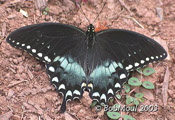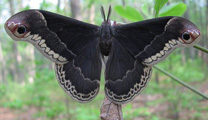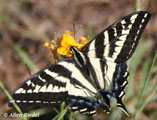Native Plants
Search for native plants by scientific name, common name or family. If you are not sure what you are looking for, try the Combination Search or our Recommended Species lists.
Sassafras albidum
Sassafras albidum (Nutt.) Nees
Sassafras, White Sassafras, Ague Tree, Cinnamon Wood, Mitten Tree, Saloop, Smelling Stick
Lauraceae (Laurel Family)
Synonym(s): Laurus albidus, Laurus sassafras, Sassafras albidum var. molle, Sassafras officinale, Sassafras sassafras, Sassafras variifolium
USDA Symbol: SAAL5
USDA Native Status: L48 (N), CAN (N)
The aromatic sassafras is a 35-50 ft., deciduous tree with horizontal branching in cloud-like tiers. The mahogany-brown bark is deeply ridged and furrowed. Little bunches of yellow-green flower balls are scattered profusely over the female tree; more sparsely on the male. Dark-blue fruits on scarlet stalks appear on female plants in late summer. Bright-green, mitten-shaped, oval, or three-lobed leaves have outstanding fall color.
The roots and root bark supply oil of sassafras (used to perfume soap) and other uses. Sassafras apparently is the American Indian name used by the Spanish and French settlers in Florida in the middle of the 16th century. This is the northernmost New World representative of an important family of tropical timbers.
Plant Characteristics
Duration: PerennialHabit: Tree
Leaf Retention: Deciduous
Leaf Complexity: Simple
Inflorescence: Panicle , Raceme
Fruit Type: Drupe
Leaf: Green
Autumn Foliage: yes
Flower: Flowers in 2 inch racemes or racemose panicles.
Fruit: Black, Blue
Bloom Information
Bloom Color: Yellow , Green , BrownBloom Time: Mar , Apr , May
Distribution
USA: AL , AR , CT , DC , DE , FL , GA , IA , IL , IN , KS , KY , LA , MA , MD , ME , MI , MO , MS , NC , NH , NJ , NY , OH , OK , PA , RI , SC , TN , TX , VA , VT , WI , WVCanada: ON
Native Distribution: S.w. ME to c. MI & extreme s.e. KS, s. to FL & e. TX
Native Habitat: Open woodlands, Roadsides, Fence rows
Growing Conditions
Water Use: LowLight Requirement: Sun , Part Shade , Shade
Soil Moisture: Moist
Soil pH: Acidic (pH<6.8)
CaCO3 Tolerance: High
Soil Description: Rich, moist, sandy loams. Sandy, Sandy Loam, Medium Loam, Acid-based
Conditions Comments: Sassafras can sucker into a small grove, but is easily controlled as a single tree. It is an appropriate tree to introduce into disturbed sites with infertile soil. It grows most quickly in fertile soil, and though it prefers well-drained situations, it will tolerate soggy feet. Except for occasional iron chlorosis caused by high pH soils, the tree is relatively free of problems. Sassafras is allelopathic and can discourage the growth of certain other plants within its root zone.
Benefit
Use Ornamental: Attractive, Blooms ornamental, Fall conspicuous, Aromatic, Mass plantingUse Wildlife: Fruit-birds.
Use Other: The bark produces an orange dye and the roots yield aromatic oil of sassafras which has been used as a fragrance in soaps and perfumes. (Kershaw)
Warning: POISONOUS PARTS: Bark. Reportedly toxic if ingested. Reportedly carcinogenic if ingested.
Conspicuous Flowers: yes
Fragrant Flowers: yes
Fragrant Foliage: yes
Attracts: Birds , Butterflies
Larval Host: Spicebush butterfly, Tiger swallow-tail, Palamedes butterflies, Pale Swallowtail.
Butterflies and Moths of North America (BAMONA)
|
Spicebush Swallowtail (Papilio troilus)  Adult Food Source |
Promethea silkmoth (Callosamia promethea)  Adult Food Source |
Pale Swallowtail (Papilio eurymedon)  Larval Host |
Propagation
Description: Sow seed outdoors in the fall or stratify the seed and sow in spring. Sassafras may be multiplied from root cuttings taken in early spring before the plant leafs out. Sassafras freely produces root suckers which can be dug and moved. Dig around the sucSeed Collection: Collect the fruits when they are filled out and dark blue. Only a small percentage of sassafras trees bear fruit. Clean the seeds before planting or storage. Briefly air dry. (Do not overdry if they are to be planted immediately. Store in sealed, refrigerated containers.
Seed Treatment: Stratify at 41 degrees for 30-60 days.
Commercially Avail: yes
Find Seed or Plants
View propagation protocol from Native Plants Network.
Mr. Smarty Plants says
Edible Plants for North Georgia
January 10, 2010
We are planning a forest food garden in the hollers of the N GA Mountains.
Which edible fruit, nut, berry, herb and creepers would be best for this reddish, clay-like soil? The food garden is in...
view the full question and answer
National Wetland Indicator Status
| Region: | AGCP | AK | AW | CB | EMP | GP | HI | MW | NCNE | WMVE |
| Status: | FACU | FACU | FACU | FACU | FACU |
From the National Organizations Directory
According to the species list provided by Affiliate Organizations, this plant is on display at the following locations:Pineywoods Native Plant Center - Nacogdoches, TX
Delaware Nature Society - Hockessin, DE
Crosby Arboretum - Picayune, MS
Texas Parks and Wildlife Department - Austin, TX
Georgia Native Plant Society - Atlanta, GA
Mt. Cuba Center - Hockessin, DE
Bibliography
Bibref 1186 - Field Guide to Moths of Eastern North America (2005) Covell, C.V., Jr.Bibref 298 - Field Guide to Texas Trees (1999) Simpson, B.J.
Bibref 1185 - Field Guide to Western Butterflies (Peterson Field Guides) (1999) Opler, P.A. and A.B. Wright
Bibref 1620 - Gardening with Native Plants of the South (Reprint Edition) (2009) Wasowski, S. with A. Wasowski
Bibref 841 - Native Alternatives to Invasive Plants (2006) Burrell, C. C.
Bibref 318 - Native Texas Plants: Landscaping Region by Region (2002) Wasowski, S. & A. Wasowski
Bibref 291 - Texas Wildscapes: Gardening for Wildlife (1999) Damude, N. & K.C. Bender
Search More Titles in Bibliography
Additional resources
USDA: Find Sassafras albidum in USDA PlantsFNA: Find Sassafras albidum in the Flora of North America (if available)
Google: Search Google for Sassafras albidum
Metadata
Record Modified: 2015-11-05Research By: TWC Staff